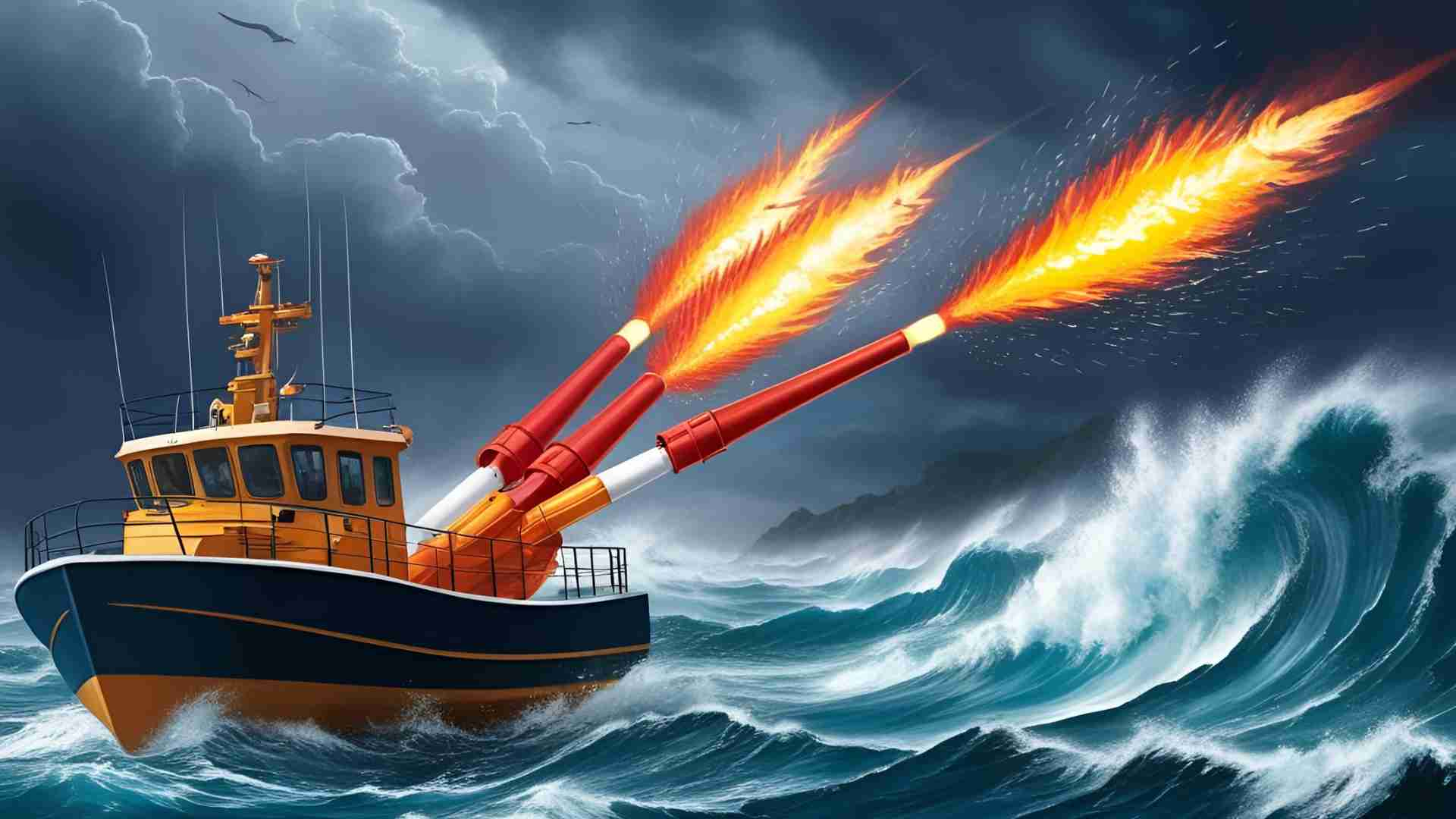How Do Marine Flares Work and Why Are They Important?
Learn how marine flares work, their types, USCG requirements, and why they’re vital for boating safety. Ensure your vessel is equipped to signal distress effectively.
Marine flares are critical safety tools for boaters, designed to signal distress and attract help during emergencies on the water. Whether you’re navigating coastal waters, the Great Lakes, or the high seas, understanding how marine flares work and adhering to U.S. Coast Guard (USCG) regulations can be the difference between life and death. This comprehensive guide explores the mechanics of marine flares, their types, legal requirements, safe usage, and disposal methods, ensuring boaters are well-equipped to handle emergencies.
What Are Marine Flares?
Marine flares are visual distress signals (VDS) used to increase a boat’s visibility during emergencies, such as accidents, medical crises, or fires. They are part of a vessel’s mandatory safety equipment, designed to alert nearby boats, aircraft, or shore-based rescuers to your location. Flares are categorized into two main types: pyrotechnic (involving flames or smoke) and non-pyrotechnic (electronic or flag-based). Both types must be USCG-approved, in good condition, and unexpired to meet legal standards.
How Do Pyrotechnic Flares Work?
Pyrotechnic flares operate by igniting a chemical mixture that produces intense light, heat, or smoke. The primary components include:
- Oxidizer: Substances like potassium nitrate or potassium perchlorate provide oxygen to sustain the combustion process.
- Fuel: Materials such as charcoal or sulfur burn to generate heat and light.
- Colorant: Compounds like strontium nitrate (for red) or magnesium (for bright white) determine the flare’s color and visibility.
When ignited, the chemical reaction creates a bright, visible signal that can be seen from miles away, depending on the flare type and conditions. Pyrotechnic flares are typically single-use and have a limited burn time, ranging from seconds to a few minutes.
Non-Pyrotechnic Alternatives
Non-pyrotechnic options, such as electronic flares (e-flares) and distress flags, are gaining popularity due to their safety and ease of use. E-flares, like the ACR ResQFlare, emit a bright, flashing SOS signal and are paired with an orange distress flag for daytime use. These devices are battery-operated, reusable, and do not expire, making them a practical alternative to traditional flares.
Types of Marine Flares
Marine flares come in various forms, each suited for specific purposes and conditions. Below is a breakdown of the most common types, their characteristics, and their intended use.
| Flare Type | Day/Night Use | Description | Burn Time | Visibility Range |
|---|---|---|---|---|
| Handheld Red Flare | Day and Night | Compact, portable flare for pinpointing location; produces 700 candlepower. | ~3 minutes | 3–5 miles |
| Red Parachute Flare | Day and Night | Aerial flare launched up to 1,000 feet; 30,000 candlepower, burns for 40 seconds. | ~40 seconds | Up to 25 miles |
| Red Meteor Flare | Day and Night | Aerial flare (12-gauge or 25mm); reaches 375–500 feet, 16,000–33,000 candlepower. | ~7 seconds | Up to 25 miles |
| Orange Smoke Signal | Day Only | Handheld or floating; produces dense orange smoke for location pinpointing. | 1–4 minutes | 3–5 miles |
| Electronic Flare (E-Flare) | Night Only | Battery-operated, flashes SOS; paired with orange distress flag for day use. | 2+ hours | Varies by model |
| Orange Distress Flag | Day Only | Bright orange flag for daytime signaling; often paired with e-flares. | N/A | 3–5 miles |
Chart: Marine Flare Types and Uses

Why Are Marine Flares Important?
Marine flares are essential for boating safety because they provide a reliable way to signal for help in emergencies. A boat in distress is more visible to rescuers when flares are deployed, significantly increasing the chances of a timely rescue. The USCG mandates that certain vessels carry VDS to ensure compliance with federal safety regulations. Non-compliance can result in fines, but more importantly, the absence of flares could delay or prevent rescue efforts, endangering lives.
When to Use Marine Flares
Flares should only be used in genuine emergencies, such as:
- Boating accidents (collisions, groundings, or capsizing)
- Medical emergencies requiring immediate assistance
- Fires or mechanical failures rendering the vessel inoperable
Using flares in non-emergency situations is illegal and can lead to costly false alarms, diverting rescue resources from actual emergencies. The USCG advises deploying flares only when there’s a reasonable chance of being seen by rescuers, such as when a vessel or aircraft is nearby. For aerial flares, fire two in quick succession to confirm your location and direction. Handheld flares or smoke signals should follow to help rescuers pinpoint your position.
USCG Requirements for Marine Flares
The USCG mandates that boats operating on coastal waters, the Great Lakes, territorial seas, or connected waters (up to where the waterway is less than two miles wide) must carry approved VDS. The requirements vary based on vessel size and operating conditions:
- Boats under 16 feet: No daytime signals required; night signals (e.g., one electric distress light or three combination day/night red flares) are mandatory between sunset and sunrise.
- Boats 16 feet or larger: Must carry three day signals (e.g., orange smoke signals or distress flag) and three night signals (e.g., red flares or e-flares), or three combination day/night signals.
Exemptions
The following vessels are exempt from carrying VDS, though carrying them is still recommended:
- Recreational boats under 16 feet
- Open sailboats under 26 feet without propulsion machinery
- Manually propelled boats (e.g., kayaks, canoes)
- Boats participating in organized events (e.g., races, regattas)
Approved Flare Options
Boaters can choose between pyrotechnic and non-pyrotechnic options to meet USCG requirements. Combination flares (e.g., red parachute or meteor flares) count for both day and night use, reducing the number needed to three. Non-pyrotechnic options, like the ACR ResQFlare (model LNK-ERS1) paired with an orange distress flag, are approved for vessels up to 65 feet in specific waters.
Choosing the Right Flare for Your Needs
Selecting the appropriate flare depends on your boating environment and needs. Below is a guide to help you decide:
- Red Parachute Flares: Ideal for open waters where help may be far away. Their high altitude and long burn time make them visible over long distances.
- Red Meteor Flares: Suitable for coastal or open waters; used with a launcher for quick deployment.
- Handheld Red Flares: Best for close-range signaling to pinpoint your location once rescuers are nearby.
- Orange Smoke Signals: Effective in daylight for marking your position, especially in calm conditions.
- Electronic Flares: A safe, reusable option for nighttime signaling, paired with an orange flag for daytime use.
Pricing and Specifications
| Product | Price (Approx.) | Specifications |
|---|---|---|
| Orion Handheld Red Flare | $20–$30 (pack of 4) | 700 candlepower, 3-minute burn, day/night use, expires in 42 months. |
| Orion Parachute Flare | $50–$70 (pack of 4) | 30,000 candlepower, 40-second burn, 1,000 ft altitude, day/night use. |
| Orion 12-Gauge Meteor | $40–$60 (pack of 4) | 16,000 candlepower, 7-second burn, 500 ft altitude, requires launcher. |
| Orange Smoke Signal | $25–$40 (pack of 2) | 1–4 minute burn, day use only, handheld or floating. |
| ACR ResQFlare (LNK-ERS1) | $80–$100 | SOS flashing light, 2+ hour runtime, no expiration, includes distress flag. |
| Heat-Resistant Gloves | $29.99 | Protects hands from burning slag during pyrotechnic flare use. |
| Safety Goggles | $19.99 | Protects eyes from flare debris and bright light. |
Note: Prices are approximate and may vary by retailer. E-flares can be purchased online without hazmat shipping fees, unlike pyrotechnic flares.
How to Use Marine Flares Safely
Proper use of marine flares is critical to ensure safety and effectiveness. Follow these steps:
- Check Wind Direction: Position yourself downwind to avoid burning debris from pyrotechnic flares.
- Read Instructions: Familiarize yourself with flare instructions before an emergency. Test e-flares periodically to ensure functionality.
- Wear Protective Gear: Use heat-resistant gloves and goggles when handling pyrotechnic flares to prevent burns or eye damage.
- Aim Away: Point flares away from yourself, the boat, and others to avoid injury or fire hazards.
- Avoid Direct Gaze: Do not look directly at the flare’s bright light to protect your eyes.
For e-flares, simply activate the device and hold, hang, or let it float. Always conserve aerial flares until you confirm a rescuer is nearby, then fire two in succession. Use handheld flares or smoke signals to guide rescuers to your exact location.
Storing Marine Flares
Proper storage extends the life and effectiveness of marine flares:
- Pyrotechnic Flares: Store in a cool, dry place (40–90°F) away from sparks, flames, or excessive heat (>167°F). Use a waterproof container to protect against moisture exposure.
- Electronic Flares: Store in a dry, accessible location and check batteries regularly.
- Safety Precautions: Keep flares out of reach of children and educate older kids on their proper use in emergencies.
Flares are stable and won’t spontaneously combust, but improper storage can render them ineffective.
Disposing of Expired Flares
Pyrotechnic flares expire 42 months after manufacture and must be replaced to meet USCG requirements. Expired flares cannot count toward the minimum VDS requirement but can be kept as backups. Disposal is regulated due to the perchlorate content, which poses environmental risks.
Disposal Options
- Donate: Offer expired flares to the Coast Guard Auxiliary or Power Squadron for training purposes.
- Contact Authorities: Reach out to local fire departments, household hazardous waste facilities, or state boating agencies for disposal guidance.
- Avoid Illegal Disposal: Never throw flares in household trash, jettison them overboard, or ignite them in non-emergencies.
The Sea Tow Foundation and USCG are working to expand disposal options and promote e-flares to reduce environmental concerns.
Responding to a Distress Signal
The maritime community operates under an unwritten code: assist fellow boaters in distress. If you see a flare or other VDS from another vessel:
- Notify Authorities: Contact the USCG or state authorities via VHF Channel 16 (156.8 MHz) or CB Channel 9. Use a mobile phone as a backup if needed.
- Assist Safely: Approach the distressed vessel only if it’s safe to do so.
- Legal Protection: The Federal Boat Safety Act’s “Good Samaritan” clause protects those who assist without liability, provided they act reasonably.
Prompt action can save lives, but prioritize your own safety.
Benefits of Electronic Flares
E-flares, like the ACR ResQFlare, offer several advantages over pyrotechnic flares:
- No Expiration: Reusable with regular battery checks.
- Longer Runtime: Operate for hours, compared to minutes or seconds for pyrotechnic flares.
- Safety: No flames, reducing risks of burns or fire hazards.
- Ease of Use: Simple operation, suitable for all ages.
- Eco-Friendly: No hazardous disposal requirements.
- Cost-Effective: One-time purchase without recurring replacement costs.
E-flares are USCG-approved for nighttime use (46 CFR 161.013) when paired with a daytime distress flag (46 CFR 160.072), making them a viable alternative for many boaters.
Conclusion
Marine flares are indispensable for boating safety, providing a critical means to signal for help in emergencies. Whether you choose pyrotechnic flares for their brightness or electronic flares for their safety and longevity, understanding their use, storage, and disposal is essential. By adhering to USCG requirements and practicing safe handling, boaters can ensure they’re prepared for the unexpected. Always carry the required number of approved VDS, check expiration dates, and store them properly. If you see a distress signal, act promptly and safely to assist. For more boating safety resources, visit the Discover Boating Blog or contact safety experts at (800) 426-6930.
Happy Boating!
Share How Do Marine Flares Work and Why Are They Important? with your friends and leave a comment below with your thoughts.
Read The Ultimate 2024 Boating Calendar: Dates to Know until we meet in the next article.






